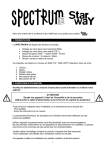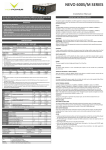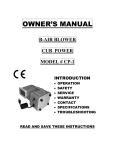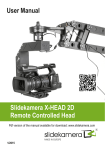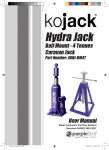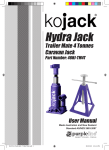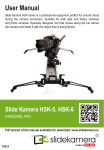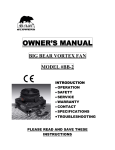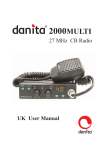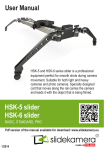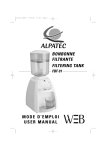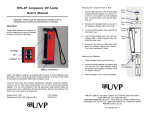Download Pni Escort Hp 8001 manual
Transcript
User Manual CB Radio PNI Escort HP 8000 ASQ 37 Before connecting and using this product, please read carrefully these instruction manual and keep it for later use. THERE ARE NO COMPONENTS THAT CAN BE REPAIRED BY THE USER. FOR REPAIRS PLEASE REFER TO A N AUTHORIZED SERVICE. ATENTION: TO PREVENT FIRE HAZZARDS USE PROPER POWER SOURCE. CONTENTS 1. 2. 3. 4. 5. 6. Main Features............................................................................................................. 4 Technical Indicators .................................................................................................... 4 Product description ..................................................................................................... 5 Installation................................................................................................................... 7 Usefull tips .................................................................................................................. 8 Legal frequencies and transmiting powers in Europe: ............................................... 8 1. Main Features • 40 AM/FM channels • P/E Frequency band selectable (Russia and EU band switchable ) • • • • • • • • • • • Mode AM/FM switch RSSI indication (4 PCS LED indications) 2 Digit channel indicator RF gain control Volume with power ON/OFF control TX/RX AS Q LED indicator Up /Down microphone Front microphone plug Jack for external speaker Manual Squelch ANT Connector 2. Technical Indicators Channels Frequency range Frequency control Operating temperature DC input voltage Size Weight Receiver IF Sensitivity Audio output Audio distortion Image rejection Adjacent channel Current drain Transmitter 40 AM/FM 26.965 – 27.405 MHz P.L.L. -10° - +55°C 13.8Vdc ±15% 115 x 36 x 152 mm 0.8 kg 1° 10.7 MHz / 2° 450 KHz -120dBm / 12dB SINAD (FM) -107dBm / 12dB SINAD (AM) @10% THD 2.5W la 8 ohm <8% at 1 KHz 65 dB 85 dB 200 mA in stand-by Maximum RF power Modulation ANT impedance Current drain 4W FM la 13.8Vdc 85% la 90% (AM) 3KHz ±0.2 KHz (FM) 50 Ohm 2A 3. Product description 1. MICROPHONE connector : Connect the supplied electric condenser microphone to this connector, and then lock it via the ring nut. 2. UP KEY : Press this key and channel NO. runs up. 3. DOWN KEY : Press this key channel NO. runs down. 4. SQ knob : The SQUELCH control allows to silent the receiver by cutting the background noise. Turn the SQUELCH knob anticlockwise until the background noise is cut. Rotate the SQUELCH knob clockwise (SQUELCH ON) to listen to the weakest signals. 5. ASQ knob : to increase the ASQ level rotate the knob clockwise, in this case the background noise is reduced but also the received signal. Recommended: turn on the radio CB with the ASQ knob on the left. 6. OFF/VOL : This knob controls the radio ON and OFF as well as adjusts the volume. If no signals are being received on the operating channel, it is suggested to turn on the SQUELCH and adjust the volume to the desired level while listening to the background noise. When it is turned on by operating the Volume knob,the radio will remember the channel, frequency, AM or FM used last time. 7. AM/FM mode selector: This switch allows selecting the modulation mode AM/ FM. 8. Emergency channel or function mode selector: with this button you can select one of the emergency channels 9/19 or the normal CH functioning mode. In the CH mode you can select the number of the channel you want to use. In Romania they use channel no22. 9. TX/ASQ LED: The indicator is bicolor light as red and green color. When TX is red color, when ASQ on is green light. 10. RX Signal Meter: 4-bar RX signal Meter to monitor the strength of the received signals. 11. DISPLAY: The digital LED display shows the channel. A. Earphone and Microphone Jack 12. ANTENNA CONNECTOR 13. 13.8 VDC POWER CORD 14. EXT (External Speaker) Jack 15. PTT (Push-to-talk) key: Push the button to talk then release to receiving mode. 16. UP key 0f the microphone: This switch allows increasing a channel number. 17. ASQ: Press this button, TX a nd ASQ on the LED wo uld be green light, shows ASQ turn on. 18. DN key of the microphone: This switch allows decreasing a channel number. 19. MICROPHONE plug: 6-pole microphone plug with locking ring nut, to be connected to socket (1) located on the front side of the radio. 4. Installation Before installing the main unit in the vehicle, please check and select the most convenient position, in order that the radio will be easy to reach and comfortable to operate without disturbing or interfering driving. Use the supplied bracket and hardware to install the radio. The bracket screws must be well tightened to avoid looseness as the vehicle vibrates. The car mounting bracket can be installed over or below the radio and the radio may be inclined as desired according to the specific type of installation (under dashboard or track cabin roof installation). Installation of the Main Unit Before connecting the radio to the vehicle electric system, please make sure the radio is powered off with the OFF/VOL (6) knob completely turned anticlockwise at OFF position. The DC power cable of the radio includes a fuse holder with fuse located on the red positive (+) wire. Please connect the DC power cable to the vehicle electric system with special attention to correct polarity, even if the radio is protected against polarity inversion. Connect the red wire to the positive (+) pole and the black wire to the negative (-) pole of the vehicle electric system. Please make sure that the wires and terminals are firmly connected, to prevent cables from disconnecting or causing short circuits. Installation of the Antenna A specific mobile antenna adjusted for 27 MHz frequency range must be used. The antenna installation must be done by a qualified technician or service center. Please install the antenna carefully on the vehicle with proper connection to ground. Before connecting the antenna to the radio, it is necessary to check the correct operation of the antenna with low standing wave ratio (S.W.R.) via adequate instruments. If not, the transmitter circuit of the radio could be damaged. The antenna usually must be installed on the highest part of the vehicle, free from obstacles and as far away as possible from any source of electric or electromagnetic noise. The RF antenna coaxial cable must not be damaged or pressed on its way between antenna and the radio. The correct operation of the antenna and the low standing wave ratio (S.W.R.) must be checked periodically. Connect the RF antenna coaxial cable to the antenna connector (15), located on the rear side of the radio. Checking Operation of the Radio Once radio has been connected to the vehicle electric system and to the antenna, the correct operation of the system should be checked. Please proceed as following: 1) Check that the power cable is correctly connected. 2) Check that the RF antenna coaxial cable is properly connected. 3) Connect the microphone to the connector (1) that is on the front side of the radio. 4) Rotate the SQUELCH (4) knob anticlockwise. 5) Turn radio on by the OFF/VOL (6) knob and adjust volume to the desired level. 6) Select the desired channel with the up/down key on the front side of the radio. 7) Rotate the SQUELCH (4) knob clockwise to cut the background noise. 8) Press the PTT key to transmit and release it to receive. 9) Check the level of the received and transmitted signals on the 4 bar RX signal Meter and TX LED. The transceiver will work correctly. 5. Useful tips • Do not invert power polarity • Do not replace the fuse with a bigger one. The default is 2A. • Do not transmit without an antenna connected, you risc damaging the device. • Set the SQ and ASQ at the limit of the background noise. 6. Legal frequencies and transmitting powers in Europe: Italy 40CH AM/FM 4 watt Italy 34CH AM/FM 4 watt Germany 80 CH FM 4watt/ 12 CH AM 1watt Germany 40 CH FM 4watt/ 12 CH AM 1watt Europe 40 CH FM 4 watt/ 40 CH AM 1watt Romania CEPT 40 CH FM 4watt Spain 40 CH AM/FM 4watt France 40 CH FM 4watt/ 40 CH AM 1watt GB 40 CH FM 4watt English frequencies + EC 40 CH FM 4 watt CEPT frequencies Specifications subject to change without notice!








